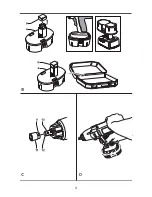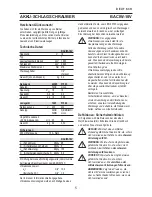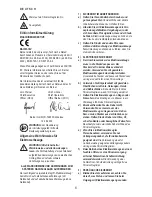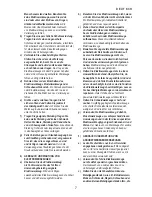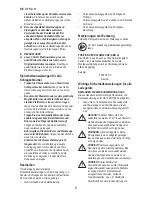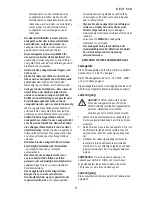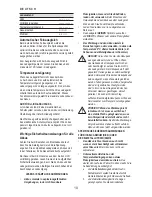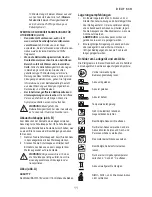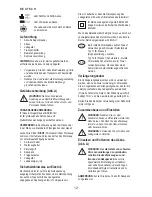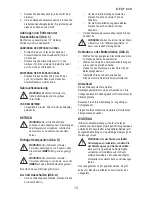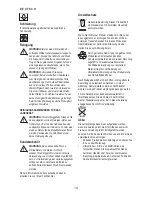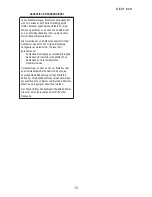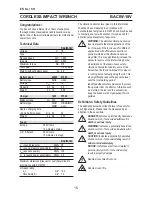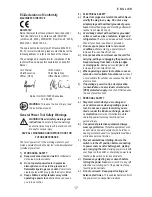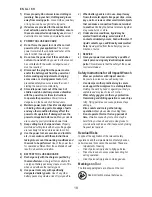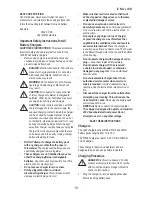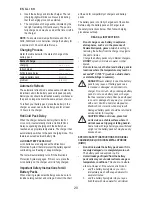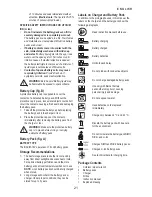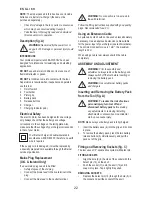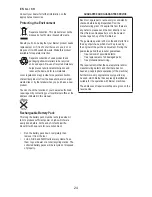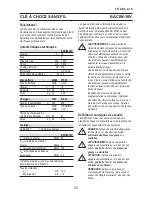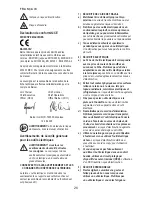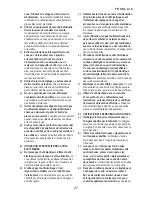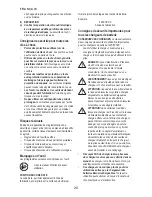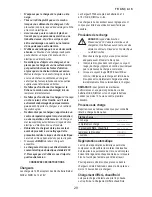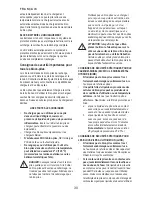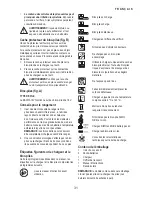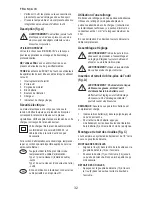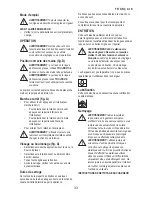
18
E N G L I S H
f)
Dress properly. Do not wear loose clothing or
jewellery. Keep your hair, clothing and gloves
away from moving parts.
Loose clothes, jewellery
or long hair can be caught in moving parts.
g) If devices are provided for the connection of
dust extraction and collection facilities, ensure
these are connected and properly used.
Use of
dust collection can reduce dust-related hazards.
4)
POWER TOOL USE AND CARE
a) Do not force the power tool. Use the correct
power tool for your application.
The correct
power tool will do the job better and safer at the
rate for which it was designed.
b) Do not use the power tool if the switch does
not turn it on and off.
Any power tool that cannot
be controlled with the switch is dangerous and
must be repaired.
c) Disconnect the plug from the power source
and/or the battery pack from the power tool
before making any adjustments, changing
accessories, or storing power tools.
Such
preventive safety measures reduce the risk of
starting the power tool accidentally.
d) Store idle power tools out of the reach of
children and do not allow persons unfamiliar
with the power tool or these instructions
to operate the power tool.
Power tools are
dangerous in the hands of untrained users.
e) Maintain power tools. Check for misalignment
or binding of moving parts, breakage of parts
and any other condition that may affect the
power tool’s operation. If damaged, have the
power tool repaired before use.
Many accidents
are caused by poorly maintained power tools.
f)
Keep cutting tools sharp and clean.
Properly
maintained cutting tools with sharp cutting edges
are less likely to bind and are easier to control.
g) Use the power tool, accessories and tool bits
etc., in accordance with these instructions
taking into account the working conditions and
the work to be performed.
Use of the power tool
for operations different from those intended could
result in a hazardous situation.
5)
BATTERY TOOL USE AND CARE
a) Recharge only with the charger specifi ed by
the manufacturer.
A charger that is suitable for
one type of battery pack may create a risk of fi re
when used with another battery pack.
b) Use power tools only with specifi cally
designated battery packs.
Use of any other
battery packs may create a risk of injury and fi re.
c) When battery pack is not in use, keep it away
from other metal objects like paper clips, coins,
keys, nails, screws or other small metal objects
that can make a connection from one terminal
to another.
Shorting the battery terminals together
may cause burns or a fi re.
d) Under abusive conditions, liquid may be
ejected from the battery, avoid contact. If
contact accidentally occurs, fl ush with water. If
liquid contacts eyes, additionally seek medical
help.
Liquid ejected from the battery may cause
irritation or burns.
6)
SERVICE
a) Have your power tool serviced by a qualifi ed
repair person using only identical replacement
parts.
This will ensure that the safety of the power
tool is maintained.
Safety Instructions for All Impact Wrench
•
Wear ear protectors with impact wrench.
Exposure to noise can cause hearing loss.
•
Use clamps or other practical way to secure
and support the workpiece to a stable platform.
Holding the work by hand or against your body is
unstable and may lead to loss of control.
•
Wear safety goggles or other eye protection.
Hammering and drilling operations cause chips
to fl y. Flying particles can cause permanent eye
damage.
•
Bits, sockets and tools get hot during
operation.
Wear gloves when touching them.
•
Do not operate this tool for long periods of
time.
Vibration caused by tool action may be
harmful to your hands and arms. Use gloves to
provide extra cushion and limit exposure by taking
frequent rest periods.
Residual Risks
In spite of the application of the relevant safety
regulations and the implementation of safety devices,
certain residual risks cannot be avoided. These are:
–
Impairment of hearing
–
Risk of personal injury due to fl ying particles.
–
Risk of burns due to accessories becoming hot
during operation.
–
Risk of personal injury due to prolonged use.
Markings on Tool
The following pictograms are shown on the tool:
Read instruction manual before use.

